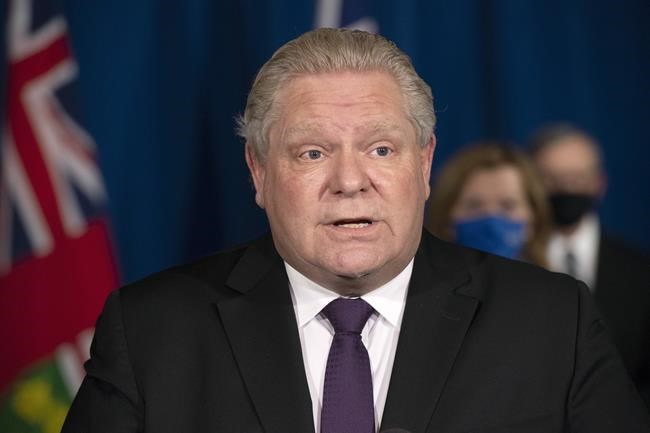TORONTO — Ontario will unveil a budget Wednesday that's expected to focus on recovering from the COVID-19 pandemic, although it remains unclear if it will chart a path to balance.
The fiscal blueprint will be the province's second pandemic budget and the government said it will contain no tax hikes or spending cuts.
Premier Doug Ford described the document as a "recovery budget" and stressed the province will spend what's needed to fight the pandemic.
"There's two aspects; protecting lives and protecting livelihoods," he said. "Making sure that we think of the future when we open up the economy and get things moving, and get people back to work."
Ontario delivered its last spending package in November after delaying its planned March 2020 release because of the pandemic. That document had record spending of $187 billion, and a record deficit of $38.5 billion.
It contained billions in cash earmarked for the health-care sector, to support for seniors living at home and to subsidize electricity rates for businesses.
Peter Graefe, a political science professor at McMaster University, said he expects Wednesday's budget will focus on pumping billions into pandemic-related services while refraining from introducing any bold new programing.
"There's a recognition that governments keeping the taps on is one reason why, even with a couple of closures in the economy in the past year ... we've managed to avoid a huge economic meltdown," he said.
Graefe said he expects the province's path to balance will be part of the document as a way for the Progressive Conservative government to signal it has an eye on long-term debt management.
But given the size of the deficit, and other elements that are difficult to predict like interest rates and economic growth, the projection may not mean much, he added.
"One way that deficit politics is important for them is not really around the economics of it, but giving the illusion of control," Graefe said. "I think it will be useful for them, electorally, even if it's really a pretty fictional pathway."
Jacob Robbins-Kanter, a PhD candidate studying Canadian politics at Queen's University, said he doesn't expect the province will chart a path to balance in the budget since a third wave of COVID-19 is underway.
"We don't know with these new variants of concern exactly what's going to happen," he said. "I don't know that we're at the stage where budget projections can account for a return to normalcy."
The government hasn't said if the budget will include a path to balance, although the finance minister has acknowledged that record deficits aren't sustainable in the long term.
Robbins-Kanter said that with an election a little over a year away, the Progressive Conservative government likely doesn't want to appear to be rolling back any services and as a result, heavy spending will continue.
"This idea of making cuts during a pandemic is much more politically risky and contentious than it would be in non-pandemic times," he said.
NDP leader Andrea Horwath said Tuesday that the Opposition would like to see the government bolster investments for long-term care and education.
The government must also provide paid sick days for workers to prevent the spread of COVID-19 as the vaccine rollout continues, she added.
"We want to see investments in jobs, we want to see investments ... to keep people safe at work," she said.
Liberal legislator John Fraser said the government should use the budget to hike pay for workers in the long-term care sector.
"The premier has been hedging his bets there," he said. "You need to give them full-time jobs because he needs to stabilize the workforce there."
This report by The Canadian Press was first published March 23, 2021.
Shawn Jeffords, The Canadian Press



